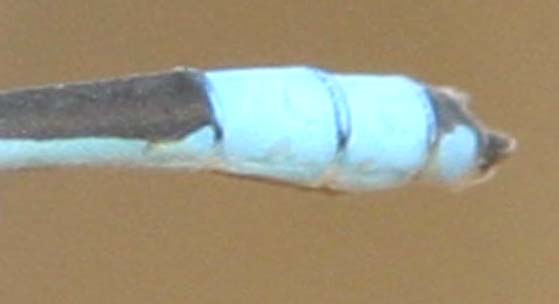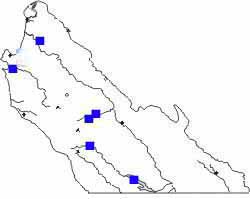TULE BLUET
Enallagma
carunculatum
|
|
Tule Bluet is a common and widespread
blue-and-black damsel of marshes and pond edges. With a close look at
the legs (as we have above with digital photography), note that the
length of the leg spines is about the same as the distance between the
spines. This helps identify this damsel as a bluet and not a dancer.
|
|
|
Like other bluets (and like dancers), the female
Tule Bluet oviposits the eggs in tandem with the male, who holds on to
assure that another male doesn't mate while she is depositing his eggs.
Females can be tan, whitish, or pale blue, but are very hard to
distinguish from the females of other bluets.
Photos (very top) 19
July 2006 Carmel R. mouth
Photos (above & below) 21 Oct 2006 Lake San Antonio
Identification of a Tule Bluet requires nice views
of a male. A key character for Tule Bluet is that, from above, the
abdomen looks like it has more black than blue. This is especially
important on the 3rd and 4th abdominal segments. Of our local bluets,
only Arroyo Bluet is similar. Familiar and Northern Bluets (and Boreal
Bluet, which could occur) are more blue than black, especially in these
middle segments.
|
|
|
|
Photo (left) 3 Aug
2006 Carmel R. mouth
Photo (right) 3 June 2007 Arroyo Seco Lakes
|
|
The two males above — seen from different angles —
illustrate the "more black than blue" pattern of Tule Bluet. There can
be quite a lot of variation in this pattern — and the black portions
atop each segment are rather 'dart-shaped' — but the entire impression
is of a "not very blue" bluet, at least compared to species like
Familiar and Northern Bluets.
The clinching character is the shape of the
abdominal appendages. The upper appendages (cerci) are tipped with a
white caruncle (giving it its latin species name), and the cerci are
not much longer than the lower appendages (paraprocts). This is all
like a slimmed down version of the long fin-like cerci on Familiar
Bluet. [The two species often occur together and have hybridized; see
Manolis 2003.]
|

|
| Tule Bluet is found commonly throughout the MTY
lowlands and into the foothills. It likes marshy ponds and lakes, quiet
reedy backwaters, and open wastewater ponds. It is also quite common
across much of California and well into the mountains. The evocative
shot below is from the east side of the Sierra Nevada. The voracious
male is devouring some small insect prey. |
|
|
|
Photo (appendage
above) 3 Aug 2006 Carmel R. mouth
Photo (full frame jut above) 14 Aug 2006 Indian Valley Reservoir, ALP
|
|
 The map shows a selection of locales at which
Tule Bluet has been found. It is likely common and widespread
throughout the county. The map shows a selection of locales at which
Tule Bluet has been found. It is likely common and widespread
throughout the county.
In MTY, the known flight dates stretch from
8 May to 21 Oct. Elsewhere in California, flight dates span Feb–Nov
(Manolis 2003).
|
|
Literature cited:
- Manolis, T. 2003. Dragonflies and Damselflies of
California. Univ. of Calif. Press, Berkeley.
Web resources:
Major identification web sites with much information on California
odes include:
For sites with excellent photos to compare for identification or to
simply
enjoy, see:
Many of these sites have links to other useful pages. Kathy Biggs's
site
is particularly useful in her selection of links. |
